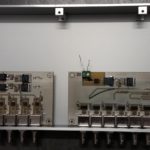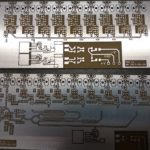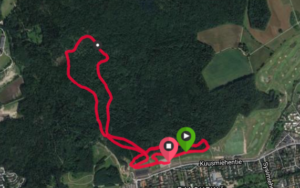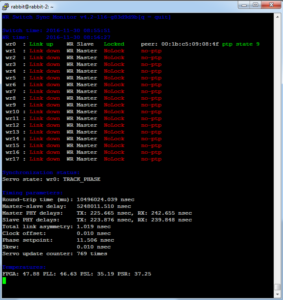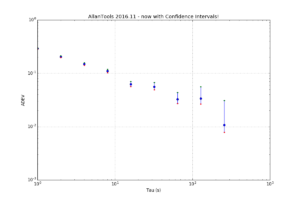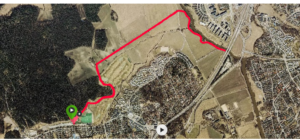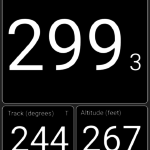import numpy
import matplotlib.pyplot as plt
import allantools as at
# this demonstrates how to calculate confidence intervals for ADEV
# using the algorithms from Greenhall2004
data_file = '../tests/phasedat/PHASE.DAT'
def read_datafile(filename):
p = []
with open(filename) as f:
for line in f:
if not line.startswith("#"): # skip comments
p.append(float(line))
return p
# read input data from file
phase = read_datafile(data_file)
# normal ADEV computation, giving naive 1/sqrt(N) errors
(taus,devs,errs,ns) = at.adev(phase, taus='octave')
# Confidence-intervals for each (tau,adev) pair separately.
cis=[]
for (t,dev) in zip(taus,devs):
# Greenhalls EDF (Equivalent Degrees of Freedom)
# alpha +2,...,-4 noise type, either estimated or known
# d 1 first-difference variance, 2 allan variance, 3 hadamard variance
# we require: alpha+2*d >1 (is this ever false?)
# m tau/tau0 averaging factor
# N number of phase observations
edf = at.edf_greenhall( alpha=0, d=2, m=t, N=len(phase), overlapping = False, modified=False )
# with the known EDF we get CIs
# for 1-sigma confidence we set
# ci = scipy.special.erf(1/math.sqrt(2)) = 0.68268949213708585
(lo,hi) = at.confidence_intervals( dev=dev, ci=0.68268949213708585, edf=edf )
cis.append( (lo,hi) )
# now we are ready to print and plot the results
print "Tau\tmin Dev\t\tDev\t\tMax Dev"
for (tau,dev,ci) in zip(taus,devs,cis):
print "%d\t%f\t%f\t%f" % (tau, ci[0], dev, ci[1] )
""" output is
Tau min Dev Dev Max Dev
1 0.285114 0.292232 0.299910
2 0.197831 0.205102 0.213237
4 0.141970 0.149427 0.158198
8 0.102541 0.110135 0.119711
16 0.056510 0.062381 0.070569
32 0.049153 0.056233 0.067632
64 0.027109 0.032550 0.043536
128 0.026481 0.033855 0.055737
256 0.007838 0.010799 0.031075
"""
plt.figure(figsize=(12,8))
plt.gca().set_yscale('log')
plt.gca().set_xscale('log')
err_lo = [ d-ci[0] for (d,ci) in zip(devs,cis)]
err_hi = [ ci[1]-d for (d,ci) in zip(devs,cis)]
plt.errorbar(taus, devs, yerr=[ err_lo, err_hi ] ,fmt='o')
plt.grid()
plt.xlabel('Tau (s)')
plt.ylabel('ADEV')
plt.title('AllanTools 2016.11 - now with Confidence Intervals!')
# just to check plot the intervals as dots also
plt.plot(taus, [ci[0] for ci in cis],'r.')
plt.plot(taus, [ci[1] for ci in cis],'g.')
plt.show() |

